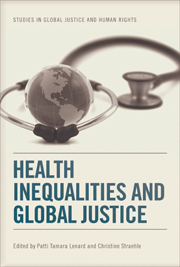Book contents
- Frontmatter
- Contents
- Acknowledgements
- Notes on the Contributors
- Introduction: Health Inequality and Global Redistributive Justice
- Part 1 A Right to Equal Health?
- Part 2 Who is Responsible for Remedying Global Health Inequality?
- 5 Re-examining the Ethical Foundations: Behind the Distribution of Global Health
- 6 Global Health and Responsibility
- 7 Outlining the Global Duties of Justice owed to Women living with HIV/AIDS in Sub-Saharan Africa
- Part 3 Measuring Health and Health Outcomes
- Part 4 Borders and Health
- Bibliography
- Index
7 - Outlining the Global Duties of Justice owed to Women living with HIV/AIDS in Sub-Saharan Africa
from Part 2 - Who is Responsible for Remedying Global Health Inequality?
Published online by Cambridge University Press: 05 August 2013
- Frontmatter
- Contents
- Acknowledgements
- Notes on the Contributors
- Introduction: Health Inequality and Global Redistributive Justice
- Part 1 A Right to Equal Health?
- Part 2 Who is Responsible for Remedying Global Health Inequality?
- 5 Re-examining the Ethical Foundations: Behind the Distribution of Global Health
- 6 Global Health and Responsibility
- 7 Outlining the Global Duties of Justice owed to Women living with HIV/AIDS in Sub-Saharan Africa
- Part 3 Measuring Health and Health Outcomes
- Part 4 Borders and Health
- Bibliography
- Index
Summary
Maternal mortality is the world's worst health inequity. Every day a thousand women die from preventable causes related to pregnancy and childbirth; 99 per cent of these maternal deaths occur in developing countries (World Health Organization 2010). There is a 400-fold difference in the Maternal Mortality Ratio (MMR) between the country with the highest MMR (Afghanistan MMR = 1,575 maternal deaths per 100,000 live births) and the country with the lowest MMR (Italy MMR = 4 maternal deaths per 100,000 live births). Recent reviews of progress on improving maternal health reveal a positive trend toward fewer global maternal deaths, from 526,000 in 1980 to 342,900 in 2008 (Hogan et al. 2010). This decrease was observed across all countries and regions with one notable exception, sub-Saharan Africa, where the MMR increased over time and accounts for over half (52 per cent) of global maternal deaths. The primary reason driving this trend is the large, feminised HIV epidemics in the region. Without HIV (or, arguably, with universal access to antiretroviral treatment services), annual maternal deaths would have been 20 per cent lower in 2008 (that is, 61,000 excess maternal deaths per year due to HIV). The starkness of this finding led the editor of The Lancet to conclude that ‘the connection between HIV and maternal health is now explicitly laid bare’ (Horton 2010).
- Type
- Chapter
- Information
- Health Inequalities and Global Justice , pp. 119 - 136Publisher: Edinburgh University PressPrint publication year: 2012



